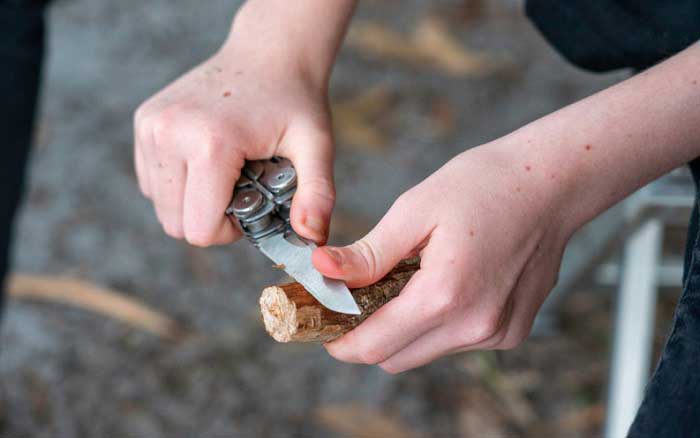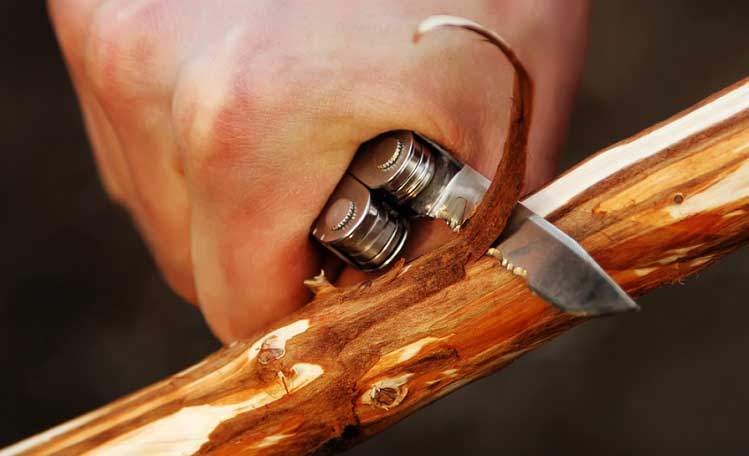
Wood whittling has been a hobby known to mankind for a long time now. We have been trying to shape wood into spears to hunt animals since the early ages.
This was passed down generation over generation and has taken a sophisticated turn. The great thing about whittling wood is that this hobby doesn’t require you to invest much.
You can start with little skill and basic tools. For centuries men have tried to learn how to whittle wood as a means to settle their minds and try out a new hobby.
If you are starting the same journey, here’s a beginner’s guide for you.
Step by Step Whittling For Beginners
This hobby is an easy one to learn. However, it still requires patience and practice. You will have to read about the techniques, tools and keep practicing. Trying to learn how to whittle wood is going to be interesting and here are all the things you need to know about.
Step 1: Knowing the Required Tools
Whittling wood does not require heavy equipment but you would need simple tools like a knife and sharpening material.
Knife

For a knife, you could use a simple one with a straight blade. The knife obviously has to be a sharp one. A blunt knife doesn’t cut wood as well as a sharp one.
As you get used to a basic knife, you could choose to invest and get an upgrade. If you choose to buy a knife for whittling go for a top quality product.
High quality knives are usually hand crafted which have blades made of tempered steel. They last longer being more durable. There are chip carving knives that you could buy.
These help you carve with a little more ease. Chip carving knives aren’t absolutely necessary for beginners though. It is obvious that with repeated usage, your knives will begin to become blunt.
Sharpening Supplies

And if you don’t want to keep buying new knives, you would need sharpening supplies. You could buy sharpening stones or use 600+ grit sandpaper along with oil, water, and a leather strop to sharpen the blade.
Sharpening a knife blade can be dangerous so make sure you get the help of an expert or go through an instruction resource before you try it out.
Step 2: Choosing the Right Kind of Wood to Carve

The most obvious requirement for this hobby is a block of wood that you can whittle. And there are a lot of options when it comes to the type of wood.
All these types of wood have a different texture and would carve in their own unique way. You have to make an informed choice about the type you want to carve. In my experience, the best wood for a beginner is basswood.
- Basswood is preferred because of the texture. It is soft, the grain is small & straight. Plus basswood is easily available which also makes it cheap.
- But this is just a suggestion, you can carve with any wood you have. Make sure you understand the texture and grain of the wood before you get whittling.
- Another important thing to check about the wood is that it should not be too wet or dry. If it is either of those, it might warp or crack while you carve.
Step 3: Understanding the Grain
Understanding the grain is one of the first things you need to know about wood whittling. This part makes your intuition grow. There’s a lot of science behind wood structures but let’s not delve into that.
- You just need to know the direction and orientation of the wood’s grain to be able to carve it easily. Wood blocks that have the grain running in one direction (straight grain) are ideal for beginners.
- An easy way to determine the grain is to judge the edges of the woodblock.
- You will easily be able to notice the direction in which the grain runs. So in more technical terms, when you carve in the same direction that the grain runs in, you are carving along/with the grain.
- If you carve in the opposite direction as the grain, it is called carving against the grain. And carving perpendicular to the grain is called carving across the grain. The best way is to carve with or across the grain.
Step 4: Whittling Safely

This is not really a step in learning how to carve but it is important none-the-less. If you don’t hold and wield the knife correctly, you will not be able to carve properly and might end up hurting yourself. The process to properly use a knife is as follows.
- If you are right – handed, hold the wood block in your left hand and the knife in your right palm. Now place the left thumb on the back of the blade to give it the pushing force.
- Push the blade through the wood gently, the force for this comes from the left thumb. Your right hand holds the handle of the knife firmly. If you try to push the knife with your right hand, the cuts would not be precise.
- Two things to remember while carving are that you should not carve in a hurry and never push the blade too deep. Carving fast will not help you carve better, it only increases the chances of getting hurt.
- Also, if you push the blade too deep, it is going to get stuck. If it does, stop and trace back. Slice the wood in thin films.
Step 5: Practice the technique

So you are set to whittle but you still need to know about the technique that helps you carve better. So what exactly happens when you carve?
Firstly, you push the blade into the wood, then angle the blade and push through the wood. It’s more like a scooping motion. This is how you keep shaving the wood bit by bit.
The wood shaving curls out in most wood types. Remember not to push too deep into the wood, the blade could get stuck because the grain changed et cetera.
Always, shave the wood in thin slices. The wood shavings are pretty informative too. You could explore the difference between the shavings when you shave against the grain versus when you shave with the grain.
And as with any hobby, you will also become a champion at “how to whittle wood” when you practice loads. The more you practice, the more you will understand the grain, the wood and the techniques.

Types of Whittling Cuts
In the last part we spoke about perfecting the technique. Like any other art form, wood whittling too has types of cuts to experiment with. The three basic cuts are (I’m assuming you’re right handed):
1. Straightaway Rough Cut
This is a technique which you use to give a general shape to your wooden block. Hold the wooden block in your left hand and make long thin sweeping cuts with the grain away from your body.
Remember to not cut too deep or else the blade might get stuck and you might end up splitting the wood.
2. Pull Stroke or Pare Cut
The name of the cut itself suggests the technique. For this technique, imagine you are peeling an apple. Hold the block in your left hand, make thin slices while holding the knife in your right hand, the blade facing towards you.
Your right thumb will be against the wood block. These cuts have to be controlled or you might end up hurting your thumb. So go slow and wear a thumb pad.
3. Push Stroke or Thumb Pushing
A push stroke has a little more power than a pull stroke. And sometimes a pull stroke gets difficult. That is when you need to switch to a push stroke.
For this type of cut, hold the wood in your left hand, the knife in your right hand and the blade should be facing away from you. Place both your thumbs on the back of the blade and push through the wood.
Your First Wood Whittling Project
In case you are excited, can’t wait to get started but can’t think of what to whittle, here’s a project idea for you. As a beginner, I would suggest you take up a simple first project. Get familiar to the feel of it and then you can proceed.

Keith Randich suggests that beginners should start their first project in trying to whittle an egg. Bet this doesn’t sound as exciting, but it is a great project to introduce yourself to the understanding of wood texture and grain.
Once you champion your first project, move on to whittling wooden shapes, animals et cetera.
Final Words
In conclusion, this is a great hobby to pick up. And every creative person should try their hand at whittling wood. It has been one of the most relaxing activities out there and it does not cost much to get started.
I hope this guide about how to whittle wood helps you through the basics. Happy whittling, remember to enjoy yourself!